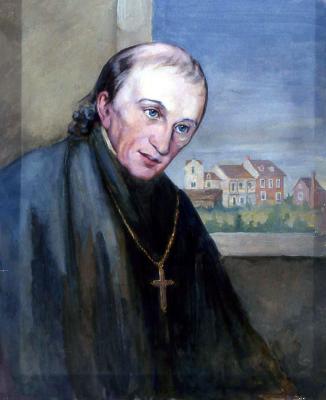President: 1799-1806
Fr. Leonard Neale, S.J., served as Georgetown's fourth president from 1799-1806. Fr. Neale expanded Georgetown's curriculum to include philosophy.
Early Jesuit career
The first of Georgetown’s presidents to be born in America, Leonard Neale grew up in Port Tobacco, Maryland. With his brother Charles, Leonard left for France at the age of twelve to study at the College of English Jesuits at St. Omers. From there, Leonard entered the Society of Jesus in 1767 and studied philosophy and theology at Bruges and then Liège before his ordination on June 5, 1773. When Pope Clement XIV suppressed the Jesuits two months later, Fr. Neale moved to England where he led a small congregation before departing for missionary work in Demerara, British Guiana in 1779. In 1783, Fr. Neale returned to Maryland where he remained at St. Thomas Manor for ten years before volunteering for a position in Philadelphia. At the time, Yellow Fever was sweeping through Philadelphia, and Fr. Neale established the city’s first Catholic orphanage for children orphaned by the disease. On March 30, 1799, at the request of Bishop Carroll, Fr. Neale became Georgetown’s fourth president, replacing Fr. DuBourg.1
Financial challenges and faculty changes
Fr. Neale became the first president to comply with the Board of Directors’ requirement that Georgetown’s president live at the college. Even with finances under the control of vice president Francis Neale, Fr. Neale’s brother, Georgetown continued to struggle financially. Old North remained unfinished, and Fr. Neale slept on a foldable cot in the library.2 At the time, Georgetown’s library consisted of only two shelves sparsely filled with books.3
Fr. Neale and his brother slowly began to release the lay faculty hired by Fr. DuBourg. Four lay faculty members left within the first seven months of Fr. Neale’s presidency. Bishop Carroll quickly sent two Sulpicians to take their place, and the remainder of the faculty consisted of a diocesan priest, a seminarian, seven candidates under the “commitment” oath, two candidates for the seminary, and two laymen. Fr. Neale required the candidates for the priesthood to “commit” to serve as professors or prefects for six years.4
Academic reforms
After he proposed new courses in Philosophy, the Board of Directors approved Fr. Neale’s plan to expand the curriculum to include logic, metaphysics, and ethics on July 27, 1801.5 Motivating in part Fr. Neale’s decision to pursue courses in philosophy was Fr. DuBourg’s newly founded St. Mary’s Seminary in Baltimore. Both Fr. Neale and Bishop Carroll were worried about losing students to St. Mary’s Seminary and hoped the new philosophy courses would attract students. However, Fr. Neale ruled with a strict disciplinary hand that made him unpopular with both students and their families.6
Convent of the Visitation
During his presidency, Fr. Neale also helped found the Georgetown Convent of the Visitation. When in Philadelphia, Fr. Neale had served as a spiritual guide for three women, Miss Alice Lalor, Mrs. McDermott, and Mrs. Sharpe. As head of Georgetown, Fr. Neale was able to send for “the Pious Ladies” and place them with the Poor Clares, who had a convent nearby. When the Poor Clares returned to France after the death of their Abbess, “the Pious Ladies” inherited the convent. In time, “the Pious Ladies” formed what became the Georgetown Convent of the Visitation.7
In 1806, Fr. Neale’s term ended, and he was succeeded by Fr. Robert Molyneux who had agreed to fill the role of Georgetown’s president a second time.
- 1Clarke, Richard H. . "The Most Rev. Leonard Neale, D.D." Lives of the Deceased Bishops of the Catholic Church in the United States. 1872, pp.116-28.
- 2“The Bicentennial History of Georgetown University: From Academy to University, 1789–1889.” 1993, p.59.
- 3“Papers Read at the Dedication of the Hirst Library and Reading Room: The History of the Senior Student’s Library.” The College Journal. Vol. 31, No. 4, p. 171.
- 4“The Bicentennial History of Georgetown University: From Academy to University, 1789–1889,” p.54.
- 5“The ‘Towered Hill.’” The Hoya, Vol. 7 Nov. 13 1925, p. 2.
- 6Georgetown University (Washington, DC), Ye Domesday Booke, 1939, p. 22.
- 7“Georgetown Visitation Centennial.” The College Journal. Vol.27, No. 9, p. 400.


